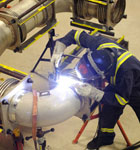1. Think big
HiFive’s introduction to the RHCC project came informally when a member of the congregation’s building team asked HiFive CEO Mark Davis to look over existing expansion designs on a five-acre property. Davis immediately noticed various site problems, including subsoil issues, but the greatest weakness was the scope of the project. “I’d met Jeff Metzger, the senior pastor, years before,” Davis says. “I thought, ‘This guy is just way too strong to be limited in this way.’”
Davis slid the plans back across the table. Within weeks, he’d located a 23-acre, semirural piece of property for sale, and HiFive’s involvement with the RHCC project officially began.

2. Create a site-specific architectural design
The project team met Tuesday nights with RHCC’s planning team to brainstorm big-picture needs for the church. Davis and Metzger would then stay to discuss more specific design ideas. The church’s baptistry—a three-story rock waterfall, located in the lobby and inspired by a trip to Cabela’s—came out of those sessions. So did the Sunday school arrival process: children check in at a computer kiosk and arrive at classrooms via slide.
HiFive negotiated with the county and state to redesign existing plans for a new road, which helped fill a 30-foot-deep ravine running through the property, and the crew dammed up the rest to create a 3.5-acre lake. Eventually, after considering 30 different design schemes, the firm went with a postmodern barn set into the hillside and overlooking the water. “It’s a spectacular place in every season,” Davis says.
3. Master-plan the facility
HiFive often cleans up after architects who are less knowledgeable about church development and growth. Its typical strategy is to design an entire campus and then scale back to an appropriate phase 1. That phase of the RHCC is already complete, but the firm has plans in place for the future, too: phase 2 includes an auditorium expansion, and phase 3 will add a children’s wing in the forest.
4. Raise financial capital
Because the RHCC had already spent $180,000 of a $400,000 reserve, HiFive, which raises capital and secures financing on its own for the majority of its projects, started from scratch. Steve Daniels, one of the church’s planning-team members and the former president of a local bank, was an instrumental help in the funding process. “I call Steve our financial guru,” Davis says. “And when Steve lost his job as a result of the economy, we immediately hired him to run our capital group.”

5. Adjust to unexpected construction costs
HiFive designed the church with a firm contract price. When construction began, though, the price of materials drastically increased, partly because of Hurricane Katrina. The project was finished on schedule, but the cost was $600,000 more than expected.
Because HiFive understood the church’s financial situation, the firm absorbed the extra expense. “The normal goal on projects like this is to break even,” Davis says, “but at the end of the day, we were happy to have done it.”
6. Incorporate state-of-the-art electronics
Many churches spend considerable funds on event programming, so HiFive installed a 36-foot movie screen on the RHCC’s stage to make the venue more flexible in its accommodation of various production-set designs. The screen is so large that the NFL threatened the RHCC with a lawsuit for trying to host a Super Bowl party. The church complied with the league’s sanction, but the situation received enough media attention that the NFL rescinded the rule the following year.
7. Continue support indefinitely
“When people come to us for business advice,” Davis says, “we always tell them the same thing: you have to give without the expectation of receiving anything in return.” HiFive dedicates half of its annual net profits back to the community and continues to resource its church projects long after construction.
Two years ago, the bank actually ordered the firm to stop giving so much away. HiFive continues its efforts anyway. “We’ve found it’s also just a great business plan,” Davis says. “We have about $30 million in backlog right now, and we’re about to sign the contracts on another $25 million in Washington, DC. Pretty good for a ragtag little company out in Mason, Ohio.” ABQ



